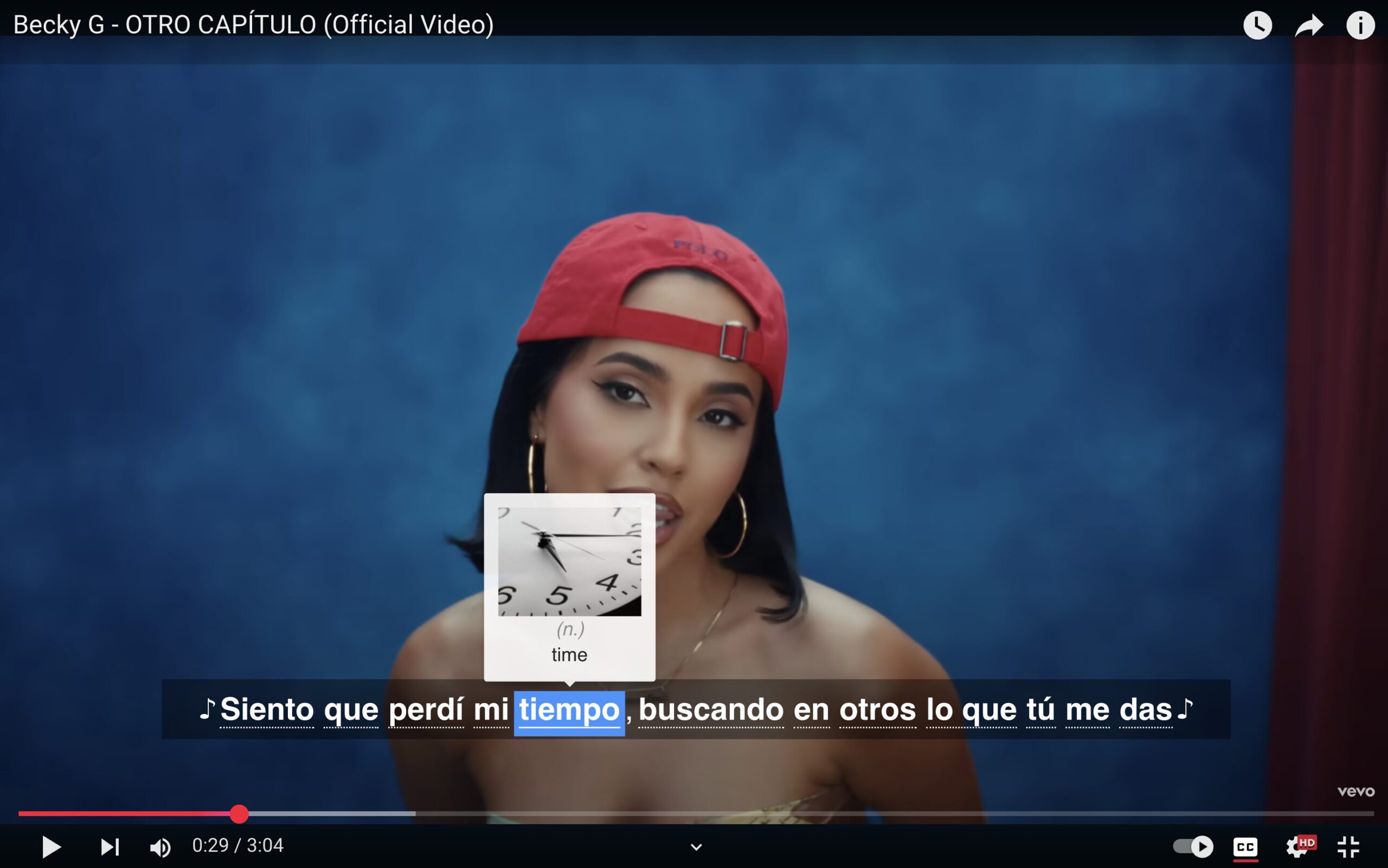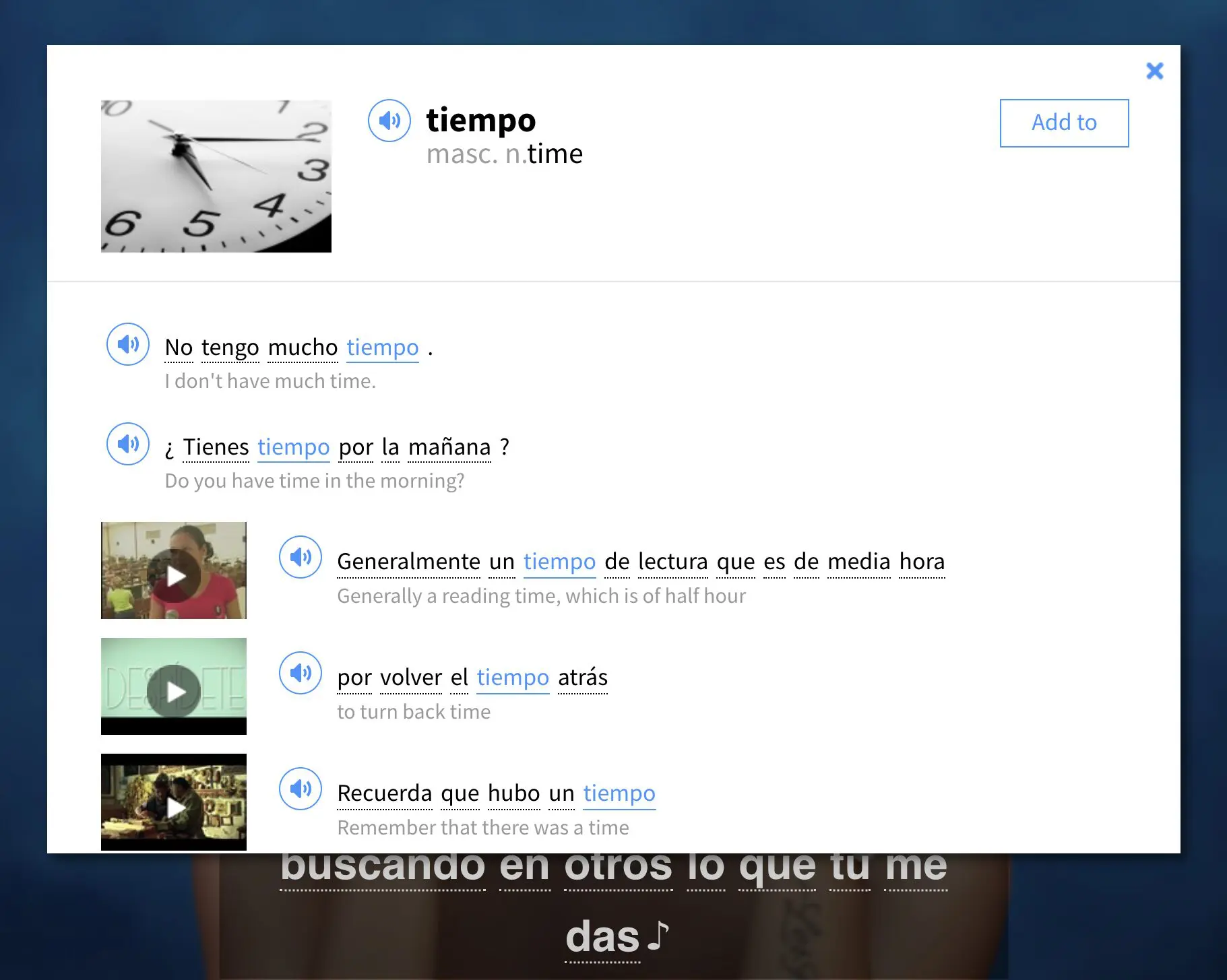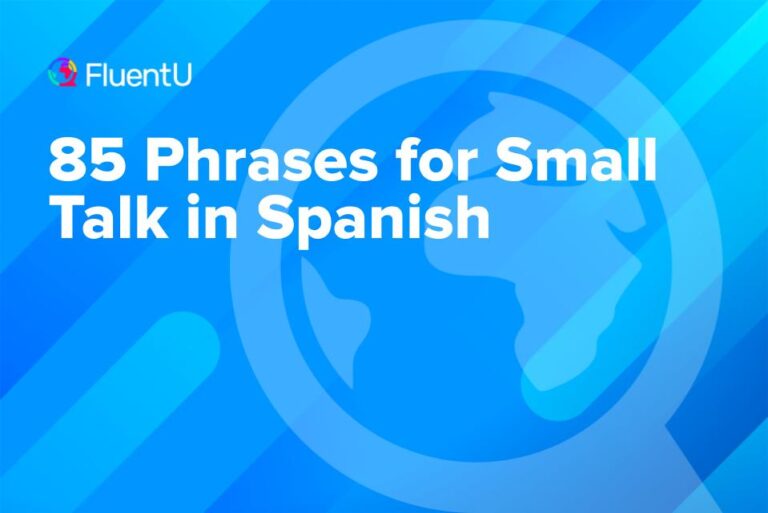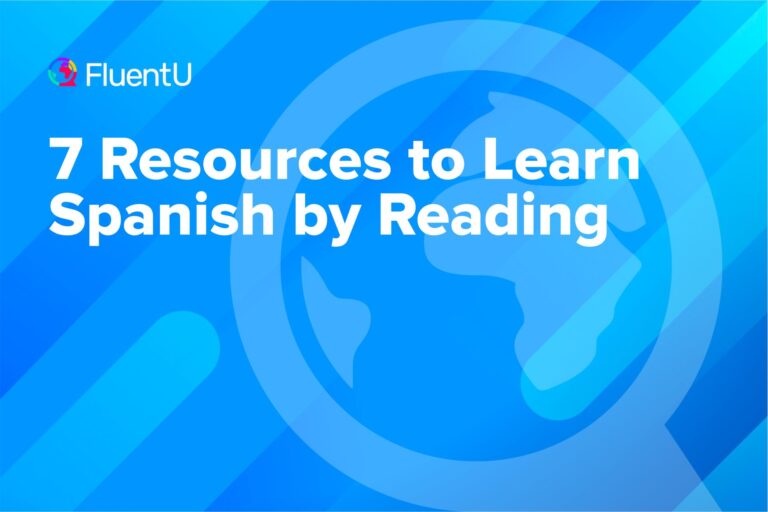Contents
- 1. You Can’t Differentiate Ser vs. Estar
- 2. You Don’t Understand Verb Conjugations
- 3. Native Speakers Talk Really Fast
- Spanish Immersion from Your Device
- 4. You Don’t Know the Difference Between the Subjunctive vs. Indicative Moods
- 5. You’re Afraid of Making Mistakes
- 6. You Have Unrealistic Goals
- 8. You’re Learning Irrelevant Vocabulary
- 9. You’re Not Good at Pronunciation
- 10. You Confuse Por vs. Para
- How to Overcome Challenges When Learning Spanish
- 1. Learn cognates and words that come from English
- 2. Use resources that encourage learning
- 3. Use both conscious and unconscious learning
- 4. Combine different learning methods and resources
- 5. Watch YouTube to learn Spanish
- 6. Bring Spanish immersion to your home
- 7. Talk with native Spanish speakers
- 8. Go to gatherings and meetups
Why Can’t I Learn Spanish? 10 Reasons Why and How to Overcome Them
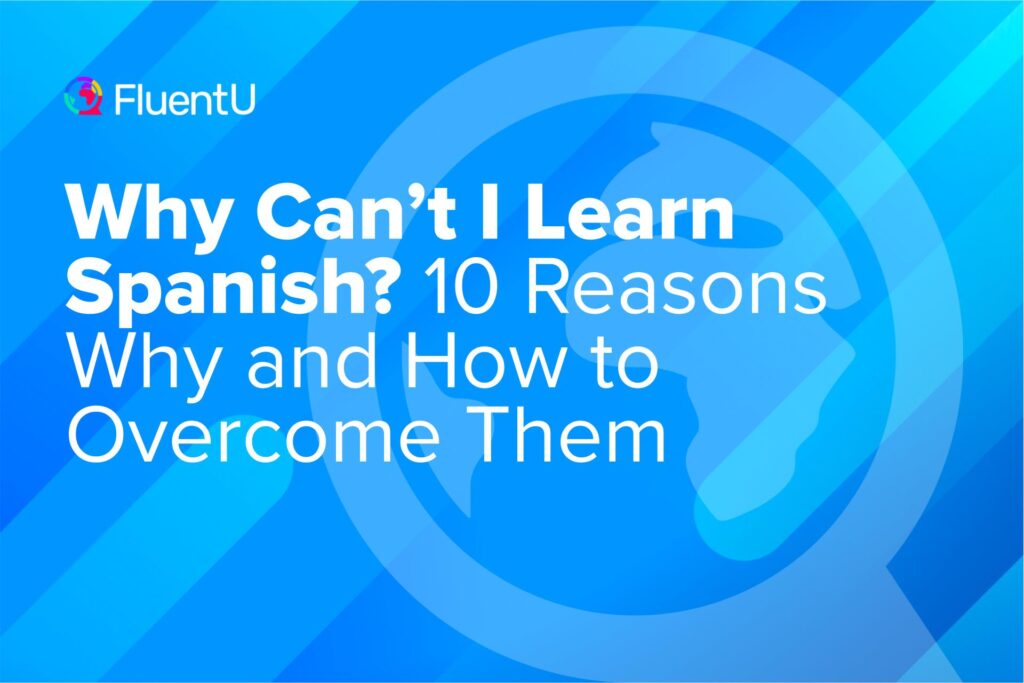
If you’ve ever struggled with studying Spanish—just couldn’t memorize those conjugations or get your mouth to pronounce the right sounds—you might feel like you just can’t learn it.
Don’t give up, though. Here are 10 reasons why you might feel like you can’t learn Spanish, plus tips on how to overcome these obstacles.
1. You Can’t Differentiate Ser vs. Estar
Ser and estar both mean “to be” but are used in different contexts. Knowing when to use each of them is one of the first challenges learners run into.
Ser is used for more permanent states, for example:
Yo soy mexicana. (I am Mexican.)
Tú eres mi hermana. (You are my sister.)
Estar is for temporary states and feelings, as well as location. For example:
Yo estoy triste. (I’m sad.)
La casa está limpia. (The house is clean.)
El supermercado está cerca. (The supermarket is close.)
If ser vs. estar is challenging for you, I recommend reading this in-depth guide:
Differences Between Ser vs. Estar (Plus Examples) | FluentU Spanish Blog
Ser vs. estar: which one should you use? Both verbs mean “to be” but how do you know which one is used in which situation? This guide will show you the differences between…
2. You Don’t Understand Verb Conjugations
Verb conjugations are the endings of the verb stem (the part of the verb that comes before -ar, -er or -ir). For example, the verb hablar in the present tense can be conjugated as hablo, hablas, habla, etc. depending on the subject.
This is a common challenge for learners because there are three Spanish moods—the indicative, subjunctive and imperative—and 18 tenses divided among them.
It can sound overwhelming, but the key is to take conjugations one at a time. First learn how to conjugate regular verbs in the present tense, then move on to irregulars. Then, you can move on to the two most common past tenses: the preterite and imperfect.
Here are a few guides to get you started:
The 18 Spanish Verb Tenses Explained | FluentU Spanish Blog
Spanish tenses are something you have to know to become fluent in Spanish. Many are used every day (like the simple present, preterite and imperfect tenses), while others…
Understanding Spanish Verb Conjugation | FluentU Spanish Blog
Spanish verb conjugation is a key step in learning the language. This guide will walk you through the basics of conjugating in Spanish as well as examples and tips. Not…
3. Native Speakers Talk Really Fast
Maybe you feel confident in your grammar skills and have a solid study routine. But no matter how much you learn, you feel like all your Spanish leaves your brain the moment you hear a native speaker talk—whether in a real-life conversation or in something like a video or podcast.
This isn’t a lack of grammar or vocabulary issue—it’s a sign that your listening comprehension skills are weak.
There are quite a few methods you can use to improve your listening skills, like shadowing and dictation exercises. The key is to use a combination of active and passive listening.
Active listening means you’re listening with the intent to understand as much as you can. You’re paying full attention to the content, pausing, replaying, maybe even writing down what you hear, etc. Passive listening is the opposite—you’re more relaxed, just listening or watching the content as if it were in your native language.
A resource that lets you do both of these at any given time is FluentU.
Spanish Immersion from Your Device
I get it–learning Spanish isn’t always a walk in the park. But it doesn’t have to be a boring, tedious, or hair-pulling experience either. In fact, making it fun is key to your success!
With FluentU, you can learn Spanish naturally by turning any YouTube or Netflix video with subtitles into an interactive language lesson. I’m talking about language immersion from the convenience of your device.
You can even import your favorite YouTube videos into your FluentU account to learn from them using the app or website. Or browse our curated library of videos handpicked for beginners and intermediate learners.
While you watch a video, FluentU’s interactive subtitles let you tap on any word for an instant definition, example sentences, images, and audio. No more pausing and searching for translations—everything you need is right there!
It's all built to help you learn how to use words in real contexts. And as you learn, you can add new words to your flaschards with just a click! For example, if I tap on the word "tiempo," this is what pops up:
Learn even faster with built-in quizzes that reinforce vocab from every video. FluentU tracks your progress, gives you extra practice with tricky words, and reminds you when it’s time to review—so your learning is always personalized and effective.
Try FluentU today on your computer or tablet, or download our app from the App Store or Google Play. Click here to take advantage of our current sale! (Expires at the end of this month.)
FluentU also has a YouTube channel that uses popular TV shows and movies dubbed in Spanish to give you in-depth lessons. The videos have bilingual subtitles and the host breaks down key vocabulary, expressions, pronunciation and cultural context they use.
4. You Don’t Know the Difference Between the Subjunctive vs. Indicative Moods
If you’re at the intermediate level, you’ll start to run into more instances of the subjunctive mood. It’s the mood you use to express desires, doubts, recommendations, wants and the like.
Verbs are conjugated differently in the subjunctive. For example, tener (to have) conjugated for the pronoun tú (you) in the present tense is tienes. But in the subjunctive, it’s tengas. For example:
Tienes dos hermanos. (You have two brothers.)
Espero que tengas un buen día. (I hope you have a good day.)
The first sentence is a fact, so it’s in the indicative mood. The second sentence is something that I am hoping will happen for the other person.
While it takes practice, differentiating between the indicative and subjunctive will get much easier with time. Meanwhile, I recommend reading this guide if it’s a challenge for you right now:
Subjunctive vs. Indicative Spanish Moods | FluentU Spanish Blog
Being able to differentiate and choose between the subjunctive vs. indicative Spanish moods is essential to becoming fluent. Read this guide to know everything you need…
5. You’re Afraid of Making Mistakes
Making mistakes is essential to your progress. But the fear of making them is a very common reason many learners get held back.
If you’re making mistakes, it means you’re living actual experiences with Spanish. That’s a good thing. But if you aren’t, it’s time to get more confident speaking and putting yourself out there.
One of the easiest ways to do this is to get an online Spanish tutor. For many people, the idea of a professional stranger whose job is to correct you makes them feel a lot more comfortable making mistakes—because they’re expected to. Tell your tutor that you want them to correct you. I used to ask my tutors to keep a Google Doc of corrections where they’d write what I said and then write the correct version next to it.
Then, make sure you actually study your mistakes and learn from them. Being corrected once and then moving on will likely lead to you making the mistake again. So be sure to write corrections down and learn them.
Two of my favorite websites for online Spanish tutors are italki and Preply. You can read our review on italki here:
italki Review: Excellent for Finding Affordable, High-Quality Online Language Tutors | FluentU Blog
Read this italki review to find out if this language tutoring platform will serve you well on your language learning journey! I’ll explain how it works, the pros and cons,…
6. You Have Unrealistic Goals
Goal setting is important when learning Spanish. But goals can also overwhelm you if you’ve set too many or if they’re unrealistic. Which will most likely end up with you quitting.
What’s realistic will be based on the time you have available, your previous experience with language learning, how fast you learn new words and various other factors. So while one person might be able to realistically learn 20 new words a day, someone else can’t.
If you’ve gotten overwhelmed by your goals in the past—or don’t know how you should set your goals—I recommend reading this guide.
How to Set Realistic Language Learning Goals | FluentU Language Learning
Language learning goals are like maps. They can give you a quick glance of where you are, where you want to be and how you can get from Point A to Point B. But what’s the…
8. You’re Learning Irrelevant Vocabulary
Lots of programs start introducing you to irrelevant vocabulary. That doesn’t mean the program is bad—you just need to supplement it with a better vocabulary resource, which you can often find for free.
For example, many people dog on Duolingo. Personally, I’ve used it to get started in many languages. The vocabulary isn’t great, but what I like about it (besides it being free) is that it teaches you sentence structures naturally. Just by writing down the sentences, I start to learn how to form my own within the first few lessons.
But I would then use free lists online of the most frequently used 1,000 or 2,000 words to study vocabulary that’s actually useful.
I consider there to be two ways you can start learning super relevant vocabulary quickly, and the one you choose will depend on your goals: seek out and learn words based on your needs (i.e., a trip to a Spanish-speaking country or vocabulary for your job) or learn the most frequently used words.
This lets you start understanding the conversations you’re most likely to have much faster than if you started by learning the numbers, colors, animals, etc.
9. You’re Not Good at Pronunciation
Pronunciation is key to being understood well, but also for remembering new words. It can get really demotivating if every time you see a new word, you can’t remember how it should be pronounced.
Or maybe you know how the words are supposed to sound, but you can’t get them to come out of your mouth right. Your tongue just doesn’t move right and you cringe at your own accent.
In either of these cases, I have a few solutions for you:
- Use audio when learning. Most online courses come with audio, but you’re going to see new words way more often in your flashcard decks. Most popular flashcard apps like Quizlet and Anki either automatically add audio to flashcards or, in the case of Anki, there are extensions you can install to easily do so. Hearing the word every time you see it will help you remember how to pronounce it.
- Practice shadowing. Shadowing is when you repeat after native speakers immediately after you hear them speak. If you haven’t ever shadowed before, it’s best to start slow—listen to a few words or a sentence at a time, then pause and repeat. Soon, you won’t need to pause and can shadow as you continue listening. We have a full guide on how to use shadowing here if you’re interested in this technique.
- Study the Spanish pronunciation rules. Have you actually ever learned Spanish pronunciation? Or are you just listening to words and trying to remember how they’re pronounced? Trust me, you’ll definitely benefit—even if just a little bit—by reading over the actual phonetic rules.
Here are a few guides to help you improve your Spanish pronunciation:
12 Spanish Pronunciation Tips You Can Use Immediately (with Audio) | FluentU Spanish Blog
Spanish pronunciation isn’t always easy to pick up. Read this guide to find 12 practical, easy-to-use Spanish pronunciation tips you can start practicing to improve your…
7 Tips to Significantly Improve Your Spanish Accent | FluentU Spanish Blog
Wondering how to improve your Spanish accent? Check out these seven tricks you can implement today to instantly improve your accent and sound more like a native speaker.…
How to Roll Your Rs in Spanish | FluentU Spanish Blog
Learn how to roll r’s in Spanish with this guide! Are you struggling with the pronunciation of this letter? If so, we have you covered! Here, you’ll find seven tips you…
Spanish Vowels (With Audio and Examples) | FluentU Spanish Blog
Spanish vowels are essential building blocks of the language. We can’t form words without them! Pronouncing these letters correctly is one major key to sounding like a…
10. You Confuse Por vs. Para
In English, there’s only one way to say “for.” In Spanish, there are two: por and para.
Even as a fluent (and heritage) Spanish speaker, when I’m talking really fast por sometimes still comes out instead of para and vice versa. Because at the end of the day, my first language will always be English. So while you might not be perfect, I promise, understanding por vs. para is simple when you put time into studying them.
Por is used to talk about reasons, travel, time durations, substitutions, prices and favors. In many cases, it can also be translated as “through” or “by.”
Para is used for talking about the person who receives an object or action, goals, opinions or personal experiences, deadlines and destinations.
For a full breakdown of the two, I highly recommend checking out this guide:
When to Use Por vs Para (Examples Included) | FluentU Spanish Blog
Generally, “por” is used to refer to the reasons or method by which something is being done, while “para” refers to what that something is being done for. This post will…
How to Overcome Challenges When Learning Spanish
1. Learn cognates and words that come from English
If you know the words actor, capital, crisis, musical, natural or vulnerable in English, you already know them in Spanish. That’s because these words are cognates—words spelled the same or similarly as in English, and have the same meaning.
Learning cognates is an easy way to increase your vocabulary fast. Here are some guides to read to help you learn them:
500+ Useful Spanish Cognates (With PDF Download) | FluentU Spanish Blog
Spanish cognates are words that sound and look like their English meanings, making them super easy to master. Click here to learn more than 500 Spanish cognates to boost…
68 Common English Words Used in Spanish | FluentU Spanish Blog
Did you know there are English words used in Spanish? They’re called English-Spanish cognates and they can give any learner a leg up in studying Spanish vocabulary. Read…
2. Use resources that encourage learning
Another great tip is to use resources designed to encourage an environment of learning. If you can slowly incorporate Spanish into your everyday life, you can overcome these early hurdles.
Of course, there are plenty of ways to “Spanishify” things you would do normally. If you love TV series, try throwing some telenovelas into the mix. If you have a specific interest—like photography, for example—find a Spanish blog about it.
3. Use both conscious and unconscious learning
There’s a difference between conscious learning and unconscious learning. Completing a university Spanish course is conscious learning. Listening to Spanish music on your way to work or watching movies in Spanish is unconscious learning.
Self-teaching at home with manuals and online materials is conscious learning. Living in Colombia and listening to people around you speak Spanish daily is unconscious learning.
Combining just the right amount of both methods can do wonders for your Spanish skills. Just keep an open mind and experiment with different methods to understand what works best for you.
4. Combine different learning methods and resources
Do you learn best from dynamic, highly visual content or more formal, structured materials? Do you prefer to study a little at a time, or follow intensive courses? Are you able to focus on your own, or is the classroom the best place to provide some sense of responsibility and accountability?
Using various strategies and resources—rather than a boring repetition of the same routine—will benefit your learning.
For example, you could join a class (in a traditional classroom or online), while using apps for learning Spanish and surrounding yourself with Spanish media such as telenovelas (soap operas), movies and music.
5. Watch YouTube to learn Spanish
If your Spanish level is intermediate or advanced, try bringing YouTube channels in Spanish into the mix.
You can learn how to get a job, make friends or talk about zombies with the YouTuber HolaSoyGerman. He’s one of the most famous Spanish-speaking YouTubers.
Butterfly Spanish is also a great channel for learning grammar and conversational vocabulary. The teacher there will teach you how to talk about being sick in Spanish, how to take a taxi in a Spanish-speaking country, correct pronunciation and more.
6. Bring Spanish immersion to your home
Even if you can’t travel to a Spanish-speaking country right now, you can still imitate that immersive language learning environment at home.
Learning Spanish stops being optional when you need it to get food, navigate your city, date and make friends. The trick is to create a similar feeling without leaving your house. Your brain must be tricked into thinking it’s urgent to learn this language.
Surround yourself with Spanish music and watch Spanish TV series or movies on a regular basis. Change the language settings on your phone, computer and other devices to Spanish. Write your to-do lists in Spanish and switch your news channels to Spanish outlets.
7. Talk with native Spanish speakers
Aside from online tutoring like we talked about earlier, I also recommend getting a language partner. This is someone who’s a native Spanish speaker trying to learn English. You talk regularly through messages and/or calls and give each other corrections, explore new topics, etc.
You’re both making mistakes because you’re both learning something new. And there are several apps that let you filter results to find someone who really matches with you—like filters for age, location, gender, etc.
I recommend using either HelloTalk or Tandem. You can check out our reviews of each one here:
HelloTalk Review: Valuable Tool for Language Learners But Matchmaking Could be Improved | FluentU Language Learning
In this review of HelloTalk, we take an in-depth look at the language exchange app and scrutinize its best (and worst) features, including their social media-like…
Tandem Review: Well Designed Language Partner App Feels Tinder-esque but Helps Learners Connect | FluentU Language Learning
Read our full Tandem review if you’re ready to dive into the world of online language exchange. Before you take the plunge, take a look at this Tandem review to find out…
8. Go to gatherings and meetups
If you’d rather take your immersion offline, meeting up with other language learners or native speakers in person could be a great way to give you that extra push forward.
You could check out Meetup for local Spanish meetings in your area. Simply put in “Spanish language club” or “Spanish language meetup” in the search bar, along with your city.
Hopefully, these tips and tricks will have helped you recover that sweet Spanish learning drive. Remember that your Spanish learning skills can always be challenged, improved and pushed forward.
Make sure you don’t neglect your inner student who feels curious about the world, and you’ll certainly master Spanish and everything else.
Download: This blog post is available as a convenient and portable PDF that you can take anywhere. Click here to get a copy. (Download)

